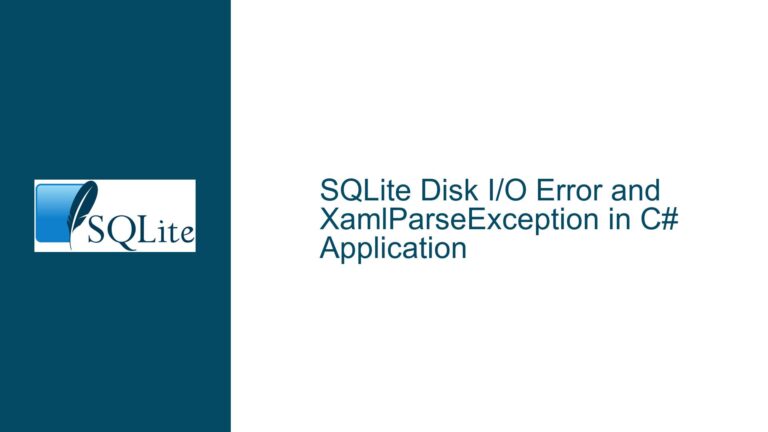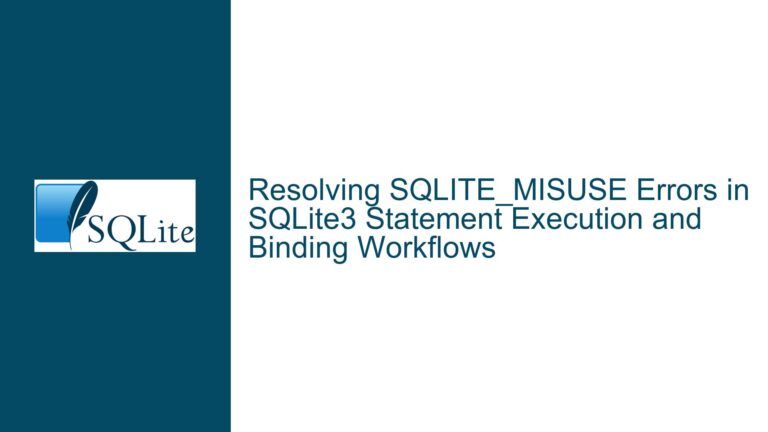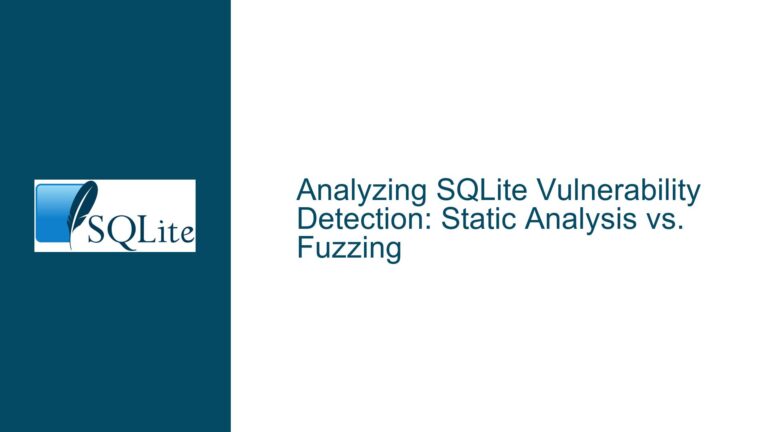SQLite 3.39.3 Symlink Resolution Breaks /proc/PID/root Database Access
Database Access via /proc/PID/root Fails Due to Symbolic Link Canonicalization
Issue Overview: SQLite 3.39.3 Enforces Strict Symlink Resolution for Journal/WAL Consistency
The core problem arises when applications attempt to access SQLite database files through Linux’s /proc/<PID>/root pseudo-filesystem paths after upgrading to SQLite version 3.39.3. This version introduced a critical change in how the Unix OS interface handles symbolic links in database filenames. Specifically, SQLite now fully resolves all symbolic links in the entire path to derive a canonical filename before opening the database. This ensures that auxiliary files like rollback journals and Write-Ahead Logging (WAL) files are consistently located relative to the resolved path.
However, /proc/<PID>/root entries are not standard symbolic links—they are kernel-generated references to a process’s root directory, which may reside in a different mount namespace (e.g., containerized environments). These pseudo-symlinks cannot be resolved using conventional readlink() operations, causing SQLite’s new canonicalization logic to fail. For diagnosis tools or monitoring systems that inspect databases in foreign mount namespaces (e.g., containers), this results in SQLite returning errors when opening databases via /proc, even for read-only access.
The incompatibility stems from two factors:
- SQLite’s Safety Mechanism: The database engine now requires a stable, absolute path to prevent corruption scenarios where journal/WAL files become unreachable due to symlink changes mid-transaction.
- /proc’s Non-Standard Behavior: The Linux
/procfilesystem exposes process-specific paths that behave like symlinks but lack the semantics of filesystem-level links. Resolving them through standard POSIX APIs returns inconsistent or invalid results.
This conflict creates a deadlock: SQLite insists on resolving all symlinks for data integrity, while /proc/<PID>/root paths defy resolution through ordinary means. The result is a breaking change for applications that rely on these pseudo-links to access databases across namespaces.
Possible Causes: Path Canonicalization Conflicts with Procfs and Mount Namespaces
1. SQLite’s Journal/WAL File Location Logic
SQLite derives the names of journal and WAL files directly from the canonicalized database path. For example, if a database is opened at /proc/12345/root/var/data/app.db, SQLite 3.39.3 attempts to resolve all symlinks in this path to determine the "true" location (e.g., /var/lib/container/12345/var/data/app.db). The rollback journal would then be named /var/lib/container/12345/var/data/app.db-journal. If any component in the path (like /proc/12345/root) cannot be resolved, SQLite cannot guarantee the integrity of transactions, leading it to reject the open request.
2. /proc//root’s Pseudo-Symlink Behavior
The /proc/<PID>/root "symlink" is a kernel abstraction that points to the root directory of a process, which may exist in a separate mount namespace (e.g., inside a Docker container or Singularity instance). Unlike filesystem symlinks:
readlink(/proc/<PID>/root)returns a string likeanon_inode:[4026532412], which does not correspond to a valid filesystem path.- The "link" is a dynamic reference to a namespace, not a static filesystem entry. Resolving it to a host-side path is impossible if the namespace is isolated.
Thus, SQLite’s attempt to canonicalize /proc/<PID>/root/... fails because the intermediate components are non-resolvable, even though the final path may validly point to a database file.
3. Inadequate Handling of Read-Only Connections
A common misconception is that read-only connections do not require journal/WAL file access. However, SQLite still checks for stale journals/WALs even in read-only mode. If a prior writer crashed without committing, the database might be in an inconsistent state. By resolving the canonical path, SQLite ensures that any existing journals are checked and applied or rolled back before allowing reads. Without this, a reader might load corrupted data, unaware of an incomplete transaction.
4. Assumption of POSIX-Compliant Filesystems
SQLite’s design assumes that the underlying filesystem adheres to POSIX semantics, where symlinks can be resolved to absolute paths. /proc violates this assumption by providing "symlinks" that are not resolvable through standard APIs. This creates a gap between SQLite’s safety checks and real-world edge cases involving namespace isolation.
Troubleshooting Steps, Solutions & Fixes: Bypassing Canonicalization for Procfs Paths
1. Use Raw File Descriptors or Handles
If your application controls how the database file is opened, avoid passing /proc paths directly to SQLite. Instead:
- Open the database file via
/proc/<PID>/root/...using low-level OS APIs. - Pass the raw file descriptor to SQLite via
sqlite3_open_v2()with theSQLITE_OPEN_URIflag andfddescriptor.
Example (C/C++):
int fd = open("/proc/12345/root/var/data/app.db", O_RDONLY);
if (fd == -1) { /* handle error */ }
char uri[256];
snprintf(uri, sizeof(uri), "file:/proc/self/fd/%d?nolock=1", fd);
sqlite3_open_v2(uri, &db, SQLITE_OPEN_READONLY | SQLITE_OPEN_URI, NULL);
This bypasses path resolution by using the already-opened file descriptor. The nolock=1 parameter prevents SQLite from attempting to create lock files, which is unnecessary for read-only access.
2. Bind-Mount Procfs Paths to Stable Locations
For systems that frequently access databases in foreign namespaces, bind-mount the target path to a stable location outside of /proc:
mkdir -p /mnt/container_12345
mount --bind /proc/12345/root/var/data /mnt/container_12345
Then open /mnt/container_12345/app.db in SQLite. This converts the dynamic /proc path into a static mount point that SQLite can resolve normally.
Caveats:
- Requires root privileges.
- Mount namespaces must remain active; unmounting prematurely breaks access.
3. Downgrade SQLite or Use Legacy Open Modes
If short-term compatibility is critical, downgrade to SQLite 3.39.2 or earlier, where symlinks in path components were not fully resolved. However, this reintroduces the risk of database corruption if symlinks change during a transaction.
Alternatively, check if your SQLite driver supports legacy open modes. For example, the Go-SQLite3 driver allows specifying _mutex=no or _txlock=immediate in the connection string, though this does not directly disable symlink resolution.
4. Custom VFS Layer for Procfs Handling
Develop a custom SQLite VFS implementation that overrides the xOpen method to skip symlink resolution for /proc paths. This advanced solution involves:
- Detecting paths starting with
/proc/<PID>/root. - Using
openat()with directory file descriptors to traverse the path without resolving symlinks. - Ensuring journal/WAL files are named relative to the unresolved path.
Example Sketch:
static int procfsOpen(
sqlite3_vfs *pVfs,
const char *zName,
sqlite3_file *pFile,
int flags,
int *pOutFlags
) {
if (strncmp(zName, "/proc/", 6) == 0) {
// Custom logic to open /proc paths without symlink resolution
int fd = openat(AT_FDCWD, zName, flags, 0644);
// ... wrap fd into pFile ...
return SQLITE_OK;
} else {
// Delegate to default VFS
return ORIG_VFS->xOpen(ORIG_VFS, zName, pFile, flags, pOutFlags);
}
}
5. Lobby for SQLite Configuration Option
Advocate for a compile-time or runtime option to disable full symlink resolution. Propose a patch to SQLite that introduces a new flag (e.g., SQLITE_OPEN_ALLOW_PROC_PATHS) to skip canonicalization for specific paths. Engage with the SQLite team via their forum or mailing list to highlight the /proc use case.
6. Container-Aware File Naming
For containerized environments, configure applications to write databases to shared volumes mounted directly in the host namespace. This avoids /proc paths entirely. For example, Docker volumes can be mounted at predictable paths like /var/lib/container_volumes/<container_id>/data, which SQLite can access without symlink issues.
7. Kernel Workaround: Procfs Alternatives
Explore Linux kernel features like namespace file descriptors (introduced in Linux 5.6) to access foreign namespaces programmatically:
int ns_fd = open("/proc/12345/ns/mnt", O_RDONLY);
setns(ns_fd, CLONE_NEWNS); // Enter target mount namespace
// Open database with regular path (e.g., /var/data/app.db)
setns(original_ns_fd, CLONE_NEWNS); // Restore original namespace
This requires careful synchronization and is unsuitable for unprivileged processes.
Final Recommendations
- Immediate Mitigation: Use file descriptors or bind mounts to bypass
/procpath resolution. - Long-Term Solution: Develop a custom VFS or advocate for a SQLite configuration option to handle procfs paths.
- Architectural Adjustment: Reconfigure containerized workloads to use shared volumes instead of relying on
/procaccess.
By understanding SQLite’s dependency on canonical paths for transaction safety and the peculiarities of /proc, developers can bridge the gap between data integrity and namespace isolation requirements.






